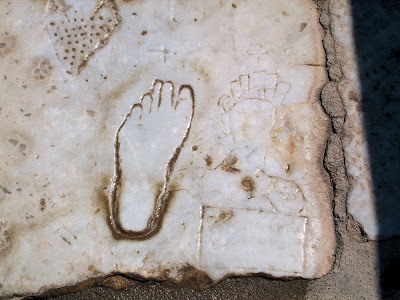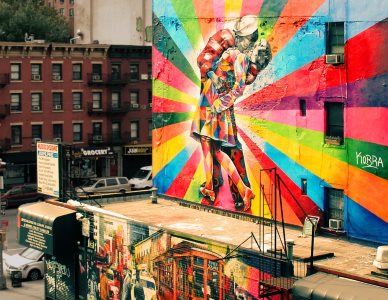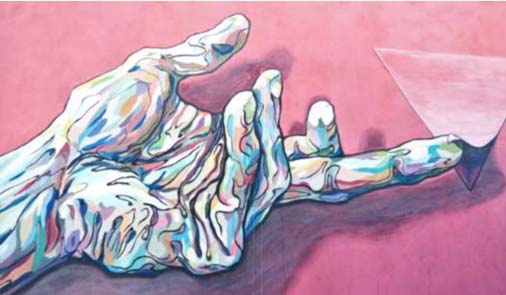
The many forms of art
There is no fixed rule that determines what exactly is an art form. There are many different new forms of art for you to explore.
Learn moreAlthough graffiti isn't usually seen in museums or galleries, it is nonetheless an accepted art form.
As an art form, graffiti's origins stem from the New York scene of the 1970s when the younger generation began to utilize materials like spray paints to make images on subway trains and buildings. Some took the form of graphic, colorful images while others were stylised tags.
 Graffiti's aesthetic has been included in many artists' work. For example, Jean Dubuffet's work included graphic motifs and tags even though
the work was mainstream in style. In recent years, graffiti artists like Banksy have seen their works being exhibited publicly in commercial
galleries and spaces.
Graffiti's aesthetic has been included in many artists' work. For example, Jean Dubuffet's work included graphic motifs and tags even though
the work was mainstream in style. In recent years, graffiti artists like Banksy have seen their works being exhibited publicly in commercial
galleries and spaces.
 Today, spray paint has been joined by marker pens as the most popular graffiti materials. However, in many countries, painting or marking
properties without the express permission of their owners is said to be vandalism and defacement. The result can be fines or even prison
sentences.
Today, spray paint has been joined by marker pens as the most popular graffiti materials. However, in many countries, painting or marking
properties without the express permission of their owners is said to be vandalism and defacement. The result can be fines or even prison
sentences.
The purpose of graffiti has always been to express a political or social message. Graffiti and hip hop music have grown up alongside each other with gang culture being reflected in the using of tagging and graffiti to mark territorial boundaries or to indicate gang-related activity.
Today, as ever, controversy still surrounds graffiti, yet this has not prevented it from becoming a developing artform with a highly contested value.
The word graffiti has long been used to refer to figure drawings and inscriptions which were found on walls of ruins like those found in Pompeii. Over time, however, the meaning of the word has changed and now it includes any type of graphic applied onto a surface in such a manner that it constitutes vandalism.
 The very first example of graffiti in a “modern style” can still be seen in Ephesus. It is believed to have been an ancient advert for a
brothel, with the graffiti showing a handprint which has a vague resemblance to a heart together with a number, a footprint and an image
of a female head.
The very first example of graffiti in a “modern style” can still be seen in Ephesus. It is believed to have been an ancient advert for a
brothel, with the graffiti showing a handprint which has a vague resemblance to a heart together with a number, a footprint and an image
of a female head.
Graffiti as we recognize it today, however, didn't arrive until the 20th century. It is most linked to the punk rock anti-establishment movement of the 1970s with bands like Crass and Black Flag stenciling their logos and names widely.
In the late 1970s, Fab 5 Freddy and Lee Quinones, two known graffiti artists, were given their own gallery opening by Claudio Bruni, an art dealer. For many people living outside the Big Apple, this was the first time that they had encountered this artform. By the early 1980s, stencil graffiti started to take off. Early examples of stencil graffiti include Blek le Rat’s work in Paris during 1981 as well as Jef Aerosol's work in Tours in 1982. By 1985, there were stenciled graffiti works in many cities around the world including Melbourne, Sydney and New York City.
 By the turn of the 21st century, graffiti had become a popular and legitimized artform in many places, and with this change came a certain
amount of commercialization. Advertising campaigns began to include this style of artwork. For example, IBM launched a campaign in 2001 in
San Francisco and Chicago which involved artists spraying symbols on sidewalks. Sony followed suit in 2005 when promoting their PSP console.
By the turn of the 21st century, graffiti had become a popular and legitimized artform in many places, and with this change came a certain
amount of commercialization. Advertising campaigns began to include this style of artwork. For example, IBM launched a campaign in 2001 in
San Francisco and Chicago which involved artists spraying symbols on sidewalks. Sony followed suit in 2005 when promoting their PSP console.
Is graffiti legal? The same question goes for street art and the answer is usually a resounding no. However, that hasn't stopped countless artists from spraying and stenciling their works on public buildings in cities around the world.
In most countries, graffiti is still considered to be criminal damage. Here are some possible penalties and sentences you can face. In the UK, for example, anyone found graffitiing a building can be prosecuted under the 1971 Criminal Damage Act. The result can be a 10-year prison sentence if found guilty of having caused damage worth more than £5000. In most cases, graffiti won't cause that amount of damage. It is only in the rare cases where someone has painted on a historic monument or building that a large amount of damage will have been caused. Therefore, a much smaller sentence is likely. When the amount of damage is worth under £5000, the offender could still face up to 3 months in jail, or alternative, a hefty fine in the sum of £2500.
 In some cases, offenders may also face prosecution under 2003’s Anti-Social, Behaviour Act. This act gives the power to local councils to
hand out an on-the-spot fine of £50 if they find anyone graffitiing a public building.
In some cases, offenders may also face prosecution under 2003’s Anti-Social, Behaviour Act. This act gives the power to local councils to
hand out an on-the-spot fine of £50 if they find anyone graffitiing a public building.
In an attempt to limit the amount of damage caused by graffiti, spray-paint can no longer be purchased by anyone under the age of 16, and anyone who sells spray paint to a minor can face a fine of £2500.
Although graffiti is illegal, artists like Banksy are still making millions from exploiting the artform. Yet even though Banksy is very famous and has had several exhibitions and artworks sold at auction, graffiti as a whole is still suffering from much controversy. For every person who loves graffiti and thinks there should be more of it, there are several who think of it as criminal damage and want it eradicated. Beauty is very much in the eyes of the beholder.
 Interestingly, there appears to be a change on the horizon in the way that graffiti is being viewed. Not only have several companies harnessed
its power over recent years as part of their advertising campaigns, but artists who have been famous for being in trouble for carrying out
graffiti in the past are now being given permission to work on public buildings. One example from recent times is that of the Swiss spray
paint artist Harald Naegeli who was once imprisoned for having graffitied public buildings.
Interestingly, there appears to be a change on the horizon in the way that graffiti is being viewed. Not only have several companies harnessed
its power over recent years as part of their advertising campaigns, but artists who have been famous for being in trouble for carrying out
graffiti in the past are now being given permission to work on public buildings. One example from recent times is that of the Swiss spray
paint artist Harald Naegeli who was once imprisoned for having graffitied public buildings.
His has now been granted a license by the Swiss authorities to paint a mural on the wall of the Grossmunster church – a symbol of the city of Zurich. Although he has had several limitations placed on his work in terms of the style, color, ownership and the length of time for which it will stay in place, this shows a move towards the acceptance of graffiti as a more mainstream form of art just like some other forms of art. Who knows what will happen in the future?

There is no fixed rule that determines what exactly is an art form. There are many different new forms of art for you to explore.
Learn more
What one art lover enjoys, another will dislike intensely. That’s the nature of art. Different artists interpret the meaning of the word in different ways.
Learn more